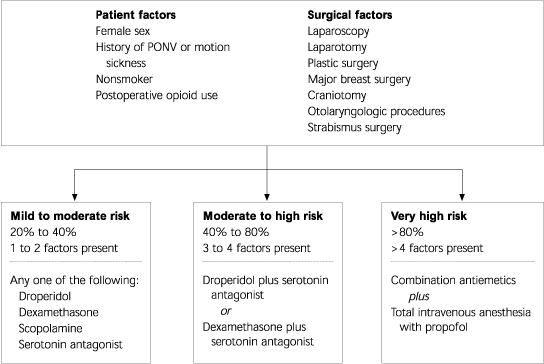
Am Fam Physician. 2002;65(11):2335-2336
A variety of factors increase the risk of developing postoperative nausea and vomiting (PONV). The overall incidence of PONV is about 30 percent but can be as high as 70 percent in high-risk patients. PONV is associated with delayed hospital discharge, decreased patient satisfaction, and increased use of resources. The cause of PONV is not well defined, but the condition seems to be mediated by various receptors, including dopamine, acetylcholine, histamine, and serotonin. Pharmacologic agents that act as antagonists of these receptors are often used to treat this condition. Gan discusses ways to prevent PONV by preoperatively identifying patients at high risk for PONV.
The three main parameters that are predictive of development of PONV are patient factors, surgical factors (i.e., type of procedure), and anesthetic factors. Patient factors include female sex, a history of motion sickness or PONV, nonsmoking status, and use of opioids in the postoperative period. One study found that patients with none, one, two, three, or all four of these risk factors had risks of developing PONV of 10, 21, 39, 61, and 79 percent, respectively. Surgical procedures associated with a higher incidence of PONV include the following: craniotomy; ear, nose, and throat surgery; major breast surgery; laparoscopy; laparotomy; and strabismus surgery. Agents used during anesthesia that are associated with an increased incidence of PONV include opioids, nitrous oxide, and volatile inhalational anesthetics.
Combining antiemetics has been shown to reduce the incidence of PONV even further than the 30 percent reduction that occurs when one antiemetic agent is used. The addition of a third agent to the regimen has not been well studied, although one study showed that using combination antiemetics plus propofol resulted in a 98 percent response rate (no nausea, vomiting, or need for rescue antiemetics). The combination most commonly used is a serotonin antagonist (such as ondansetron, granisetron, or dolasetron) plus a dopamine antagonist (such as droperidol) or a corticosteroid (dexamethasone). The serotonin antagonists are effective and have few side effects. Droperidol is an effective antiemetic, but metoclopramide is no more effective as an anti-emetic than placebo.
Dexamethasone can apparently be used safely in one dose of less than 8 mg, but larger doses and prolonged use (longer than seven days) may cause adverse effects, such as avascular necrosis of the femoral head. Droperidol is not recommended as first-line therapy because it may prolong the QTc interval and cause fatal arrhythmias; however, the author states that there are no peer-reviewed case reports of adverse cardiac effects in the past 31 years of droperidol use. The U.S. Food and Drug Administration suggests electrocardiographic monitoring before and after treatment with droperidol.

Use of high-concentration oxygen (80 percent given intraoperatively along with general anesthesia) instead of low-concentration oxygen (30 percent) reduces PONV, although the mechanism of action is unclear. Total intravenous anesthesia with propofol reduces the absolute risk of PONV when compared with isoflurane. Propofol appears to be ineffective, however, when used only as an induction agent. The perioperative use of ginger or over-the-counter antiemetics is not effective at reducing PONV. Emetic symptoms can be reduced in patients having ambulatory surgery by using ondansetron tablets that disintegrate when taken orally.
The author concludes that determination of the patient, surgical, and anesthesia risk factors can help determine which patients are at high risk for developing PONV and guide the choice of antiemetic therapy (see the accompanying figure).